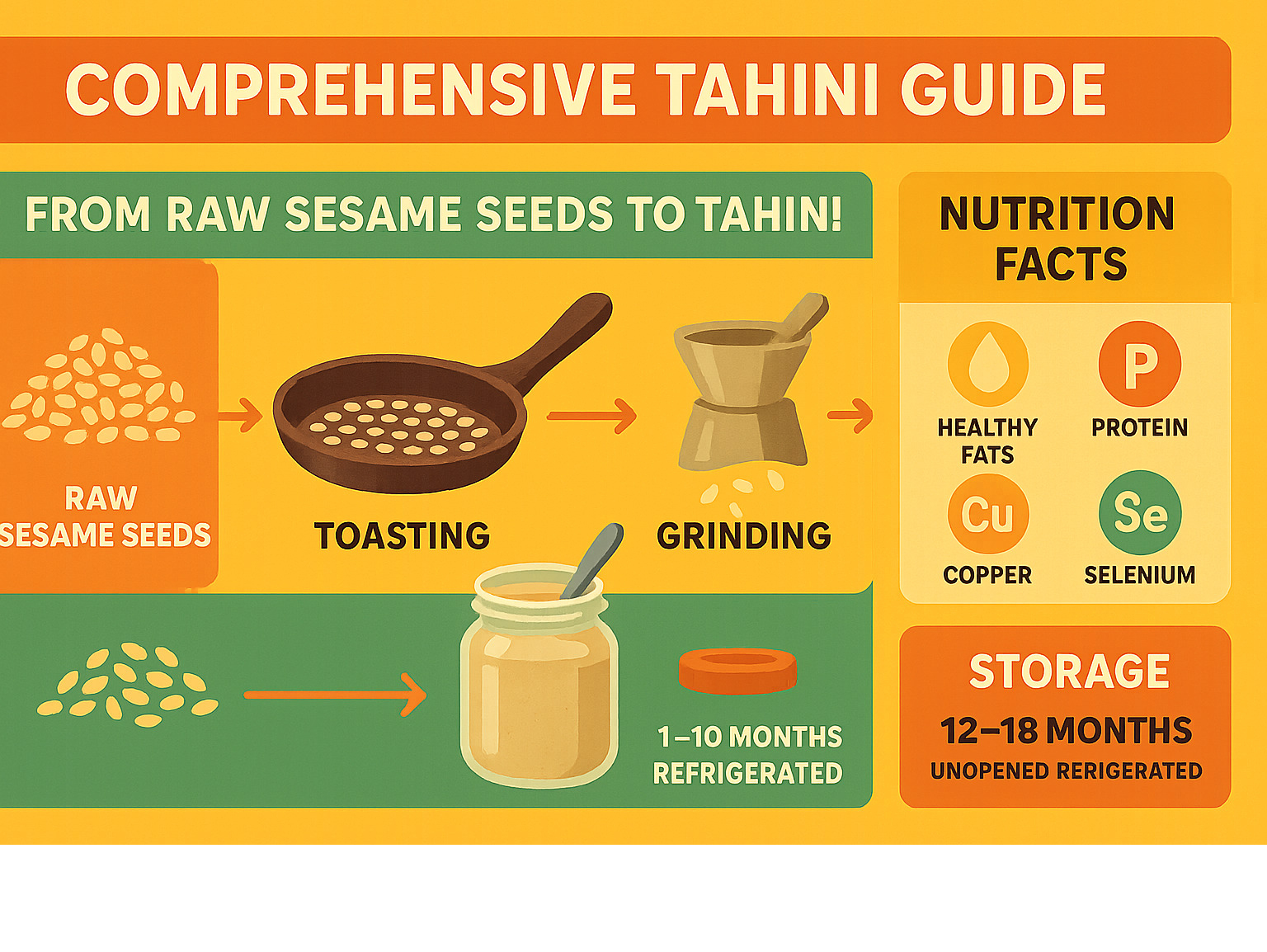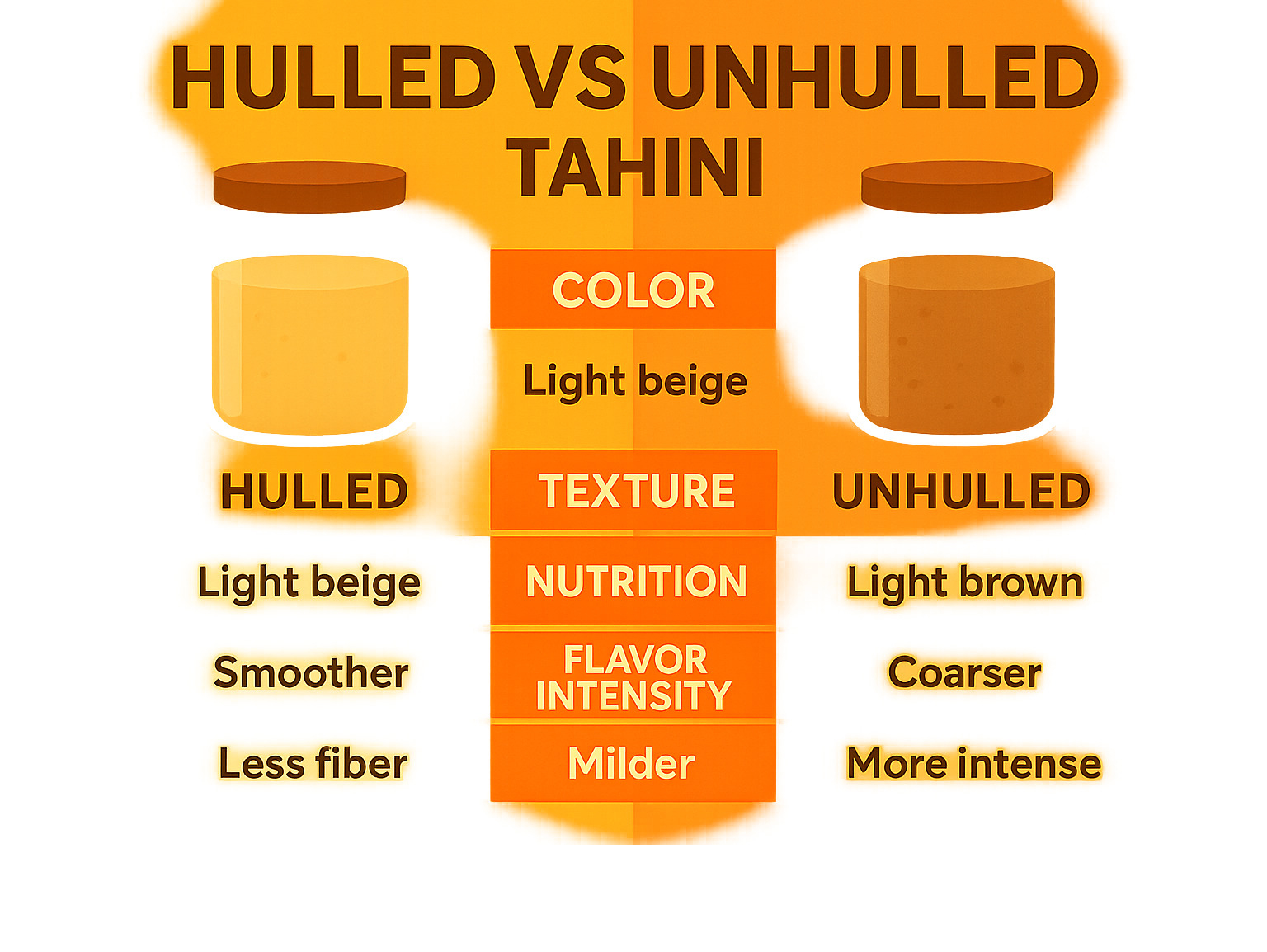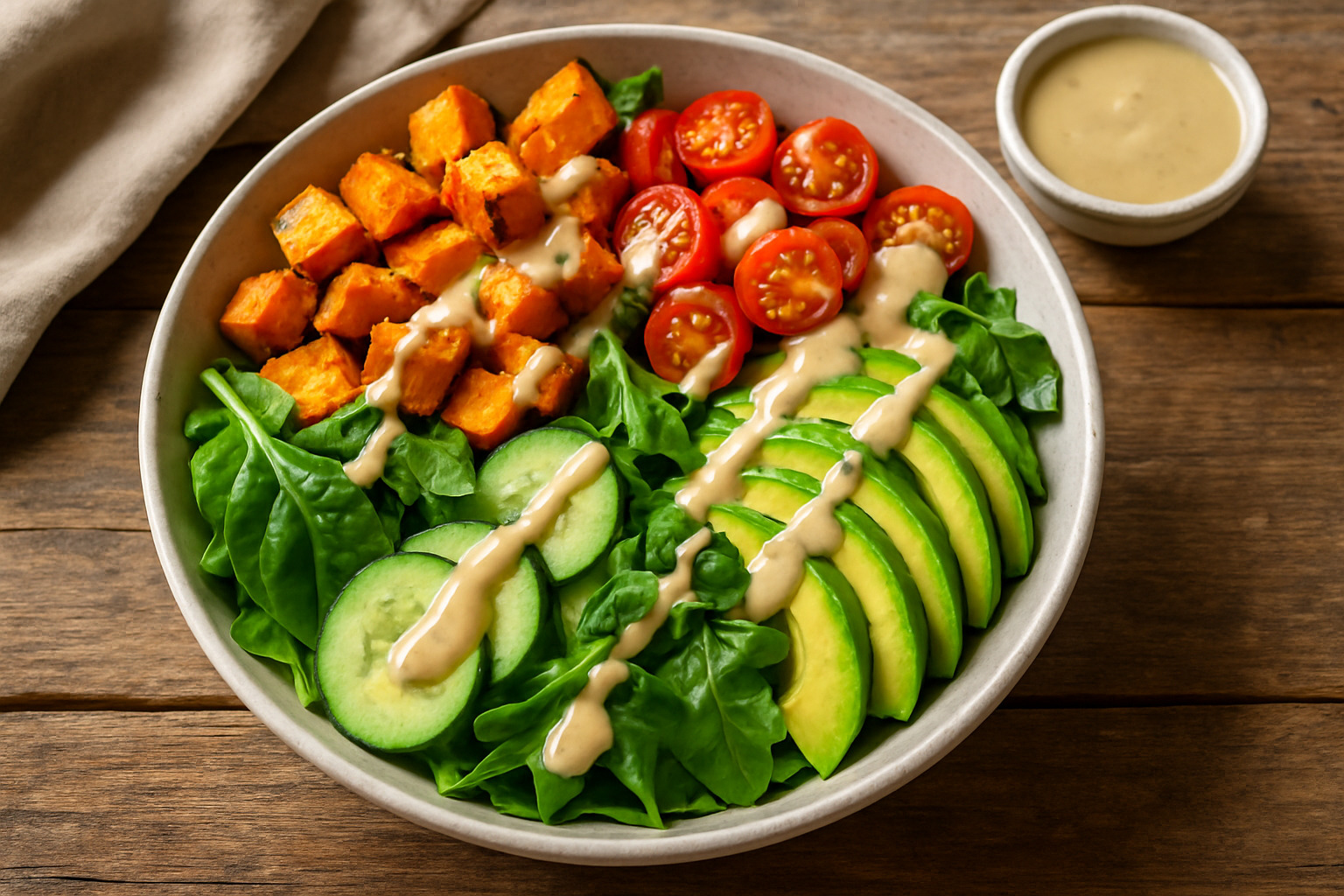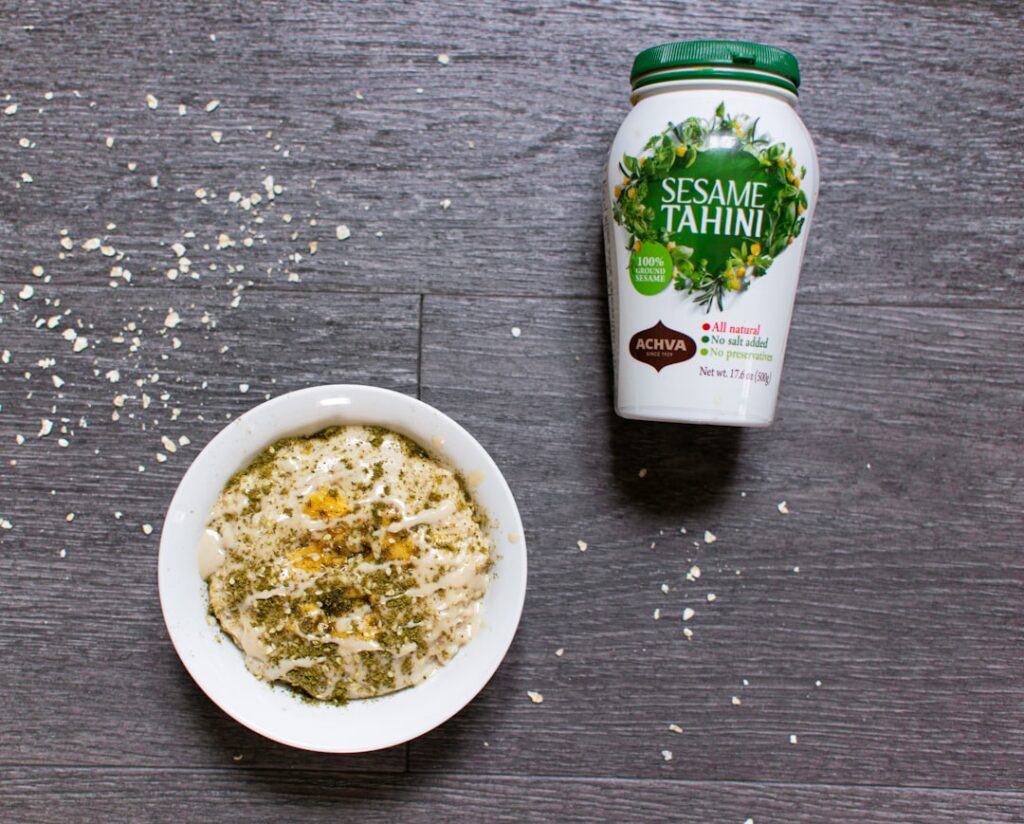What Makes Tahini a Global Culinary Essential
Tahini is a creamy paste made from ground sesame seeds that has become one of the most versatile ingredients in kitchens worldwide. This Middle Eastern staple brings a rich, nutty flavor to everything from classic hummus to modern smoothie bowls.
Quick Tahini Facts:
- What it is: Ground sesame seed paste
- Taste: Nutty, slightly bitter, savory
- Main types: Hulled (smooth) and unhulled (robust)
- Uses: Dips, sauces, dressings, desserts
- Nutrition: High in healthy fats, protein, copper, and selenium
- Storage: 12-18 months unopened, 1 month refrigerated after opening
The ancient origins of tahini trace back over 4,000 years to Mesopotamia, where cuneiform tablets describe sesame wine offered to gods. As food historian Herodotus noted 3,500 years ago, sesame cultivation flourished along the Tigris and Euphrates rivers, laying the foundation for what would become a cornerstone of Mediterranean and Middle Eastern cuisine.
Today’s food travelers encounter tahini in countless forms – from the silky Lebanese version that transforms chickpeas into perfect hummus, to Gaza’s deep red tahina with its intense roasted flavor. Whether you’re exploring authentic dining experiences in New York City or recreating global flavors at home, understanding tahini opens doors to a world of culinary possibilities.

Simple guide to tahini terms:
What Is Tahini? Origins, History & Taste
The word tahini comes from the Arabic root ṭ-ḥ-n, which simply means “to grind.” It’s a fitting name for this ancient paste that transforms humble sesame seeds into something truly special through the power of grinding and patience.
Tahini’s story begins in ancient Mesopotamia, where cuneiform tablets from 4,000 years ago describe sesame wine being offered to the gods. The Greek historian Herodotus wrote about sesame cultivation flourishing along the Tigris and Euphrates rivers 3,500 years ago, laying the groundwork for what would become a cornerstone of Middle Eastern cuisine.
By the 13th century, Arabic cookbooks were already featuring recipes for hummus kasa that included tahini as a key ingredient. The journey from ancient staple to modern pantry essential continued when raw nut butters, including tahini, started appearing in North American health food stores by 1940.
Flavor Profile of Tahini
Tahini offers a flavor experience that’s completely different from your typical nut butter. The first thing you’ll notice is its nutty, savory taste with a distinctive toasted aroma that comes from properly roasted sesame seeds. Unlike sweet almond or peanut butter, tahini brings complex umami notes to the table.
That slight bitterness you taste isn’t a mistake – it’s actually one of tahini’s greatest strengths. This natural astringency creates the perfect balance that makes tahini so versatile. When you mix tahini with acidic ingredients like lemon juice, that bitterness transforms into brightness, creating the magical harmony that makes tahini-based sauces absolutely irresistible.
Cultural Timeline of Tahini
The evolution of tahini tells the story of human culinary creativity across millennia. Ancient Sumerians liftd sesame seeds from simple crops to sacred offerings, creating sesame wine for religious ceremonies. During medieval times, Arabic cuisine transformed tahini from a simple paste into a sophisticated condiment.
The 20th century marked tahini’s change into a truly modern pantry essential. As global trade expanded and food cultures began mixing, tahini adapted to new environments while keeping its essential character. Today, scientific research on tahini nutrition continues to reveal why our ancestors were so drawn to this remarkable food.
How Tahini Is Made & The Two Main Types
The art of making tahini begins with a process that hasn’t changed much in thousands of years. Traditional producers start by soaking sesame seeds in water, which loosens the papery outer bran. The soaked seeds are then crushed and placed in salt water, where the heavier bran sinks while the lighter kernels float to the surface.
After skimming off these floating kernels, they’re toasted to develop that distinctive nutty aroma. Finally, the toasted seeds are ground between stone mills until they transform into the silky paste that graces our favorite Middle Eastern dishes.
Modern commercial production has streamlined these steps, but the heart remains unchanged: hull (or choose not to hull), toast to perfection, and grind until smooth. The decision of whether to remove those outer hulls creates two completely different types of tahini.

Hulled Tahini: Smooth & Mild
When sesame seeds shed their outer shells, they create hulled tahini – the golden, creamy paste that most of us know and love. This variety has a lighter color and smoother texture that spreads like silk. The hulling process removes the fiber-rich outer layer, which also takes away some of the natural bitterness.
Hulled tahini is the friendly introduction to the sesame world. Its mild, approachable flavor makes it perfect for newcomers and it’s the star ingredient in most restaurant hummus because of its consistently creamy texture.
Unhulled Tahini: Robust & Nutritious
Unhulled tahini is the bold cousin that keeps every part of the sesame seed intact. This darker, more textured paste carries the full nutritional punch of the complete seed, including significantly higher levels of calcium and fiber. The trade-off? A more pronounced bitter edge and rustic texture.
This robust tahini doesn’t shy away from strong flavors. Its intense sesame character can stand up to garlic, spices, and acidic ingredients without getting lost. Health-conscious cooks often prefer unhulled tahini for its superior nutritional profile.
DIY Tahini at Home
Making tahini in your own kitchen is surprisingly straightforward. Start with four cups of hulled sesame seeds – this will give you about two cups of finished paste.
The secret lies in proper toasting. Heat a dry skillet over medium-low heat and add your seeds, stirring constantly for three to five minutes until they smell nutty and turn light golden.
Pour your toasted seeds into a high-powered blender or food processor and pulse until they form a crumbly paste. Add two to four tablespoons of neutral oil, then let the machine work its magic. After two to three minutes of processing, you’ll witness the amazing change from ground seeds to smooth, creamy tahini.
Cooking with Tahini: Classic to Creative Uses
There’s something magical about tahini that transforms ordinary ingredients into extraordinary dishes. This creamy sesame paste has been the secret weapon in Middle Eastern kitchens for centuries, and modern cooks are finding its incredible versatility extends far beyond traditional hummus.
Whether you’re working with locally sourced ingredients from your farmers market or exploring global flavors in your own kitchen, tahini acts as the perfect culinary bridge. Its rich, nutty flavor adds depth to simple vegetables while providing the creamy texture that makes plant-based dishes truly satisfying.

Traditional Tahini Recipes
Hummus showcases tahini at its finest – that silky, restaurant-quality texture comes from using plenty of good tahini and whipping it with the cooking liquid from your chickpeas.
Baba ghanoush tells a different story about tahini’s talents. Here, the paste balances the intense smokiness of charred eggplant with its mellow nuttiness. Halva proves that tahini can be just as compelling in desserts, combining with sugar to create something both familiar and exotic.
For the simplest introduction, try making basic tahini sauce: mix equal parts tahini and lemon juice, add minced garlic and thin with water until it reaches your desired consistency.
Creative Ways to Use Tahini
Modern kitchens have acceptd tahini in surprising ways. Smoothies benefit enormously from a spoonful – it adds protein and healthy fats while creating creamy texture that rivals any dairy-based drink.
Tahini cookies have become the sophisticated cousin of peanut butter cookies. They’re naturally gluten-free with a more complex flavor. Granola gets a major upgrade when you use tahini as a binding agent, creating clusters that hold together beautifully.
Grain bowls might be where tahini truly shines in modern cooking. A simple tahini dressing transforms a collection of grains and vegetables into something that feels like a complete, satisfying meal. For more inspiration, check out this recipe page for creative ways to use tahini.
Cooking with Tahini: Flavor-Boosting Tips
Working with tahini successfully means understanding its personality. The natural bitterness isn’t a flaw to hide – it’s a feature to balance. Acidic ingredients like lemon juice or vinegar brighten tahini’s flavor and create perfect harmony.
Temperature matters more than you might think. Cold tahini behaves like thick paste, while room-temperature tahini becomes cooperative and smooth. Sweetness can tame excessive bitterness – a small amount of maple syrup helps create balance without masking tahini’s distinctive character.
Nutrition, Health Benefits & Allergens
When you dig into the nutritional profile of tahini, you’ll find why this ancient paste has sustained communities for thousands of years. Just one tablespoon delivers 89 calories packed with 3 grams of protein, 8 grams of healthy fats, and an impressive mineral lineup.
The real nutritional stars in tahini are copper and selenium – a single tablespoon provides 27% of your daily copper needs and 9% of your selenium requirements. You’ll also get solid phosphorus, which works alongside calcium to keep your bones strong.
What makes tahini particularly heart-friendly is its fat composition. The fats consist mainly of unsaturated fatty acids – the kind that actually support cardiovascular health. Scientific research on tahini nutrition shows that regular sesame seed consumption can help reduce LDL cholesterol and triglycerides.
The science backing tahini’s health benefits keeps growing. A 2014 study followed 50 people with osteoarthritis who added 40 grams of sesame seeds to their daily diet. After two months, they showed significant reductions in both LDL cholesterol and triglycerides. Research shows daily sesame consumption may lower inflammatory markers linked to chronic disease.
Tahini for Plant-Based Eaters
For anyone exploring plant-based fine dining or simply trying to eat more plants, tahini becomes an invaluable ally. That 3 grams of protein per tablespoon adds up quickly when you’re drizzling tahini sauce over grain bowls.
The calcium content deserves special attention – two tablespoons provide about 15% of your daily calcium needs. This makes it particularly valuable for plant-based eaters who need reliable non-dairy calcium sources.
Potential Downsides & Allergen Guidance
While tahini offers impressive health benefits, there are important safety considerations. Sesame allergies can trigger severe reactions, including life-threatening anaphylaxis. Cross-contamination during processing poses additional risks for people with multiple food allergies.
The omega-6 fatty acid content requires some nutritional awareness. The solution isn’t avoiding tahini – it’s pairing it with omega-3 rich foods like walnuts or flax seeds to maintain healthy proportions. Moderation remains key with any calorie-dense food.
Buying, Storing & Troubleshooting Tahini
Finding exceptional tahini starts with knowing what to look for on the grocery store shelf. The best tahini comes from high-quality sesame seeds that have been carefully processed. The ingredient list should tell a simple story – ideally just sesame seeds, maybe with a pinch of salt.
Organic tahini represents one of the smartest sustainable food choices you can make. These products come from sesame seeds grown without synthetic pesticides, supporting both your health and environmental responsibility.
Color offers valuable clues about quality. Premium hulled tahini displays a light, creamy beige appearance, while unhulled varieties show deeper golden or brown tones. Quality tahini should feel smooth when stirred, without excessive grittiness.
Storing Tahini: Shelf Life & Spoilage Signs
Smart storage transforms tahini from a pantry gamble into a reliable kitchen staple. Unopened jars can live happily in your pantry for up to 18 months in cool, dark spaces. Once opened, refrigerated tahini maintains quality for up to 12 months, though it will thicken considerably in the cold.
Homemade tahini plays by different rules, staying at peak quality for about one month in the refrigerator.
Recognizing spoilage signs protects your recipes and taste buds. Fresh tahini smells pleasantly nutty, while rancid tahini develops a sharp, sour odor. Any visible mold growth means it’s time to toss the jar. Oil separation looks alarming but it’s perfectly normal – a good stir brings everything back together.
Problem-Solving Common Issues with Tahini
Even the best tahini can present challenges, but most problems have simple solutions. Oil separation ranks as the most common concern, yet it’s easily fixed by stirring thoroughly.
Overly bitter tahini responds beautifully to strategic additions. A squeeze of fresh lemon juice works wonders, as does a splash of good vinegar. A drizzle of maple syrup can tame harsh edges.
Thick, stubborn tahini just needs gentle coaxing. Start by whisking in warm water one tablespoon at a time. The paste might initially seize up, but keep whisking patiently for smooth, creamy perfection.
Regional Variations, Substitutions & Sustainability
The beauty of tahini lies in how different cultures have made it their own. Chinese sesame paste offers a fascinating contrast – the seeds get roasted much longer, creating a darker paste with an intense nutty flavor that’s less bitter than traditional tahini.
Gaza’s famous red tahina represents perhaps the most dramatic regional variation. Through extended roasting, local producers create this rust-colored paste that delivers wine-like complexity. Greek breakfast culture has acceptd tahini mixed with honey to create tahin-pekmez, changing morning bread into something special.

When You Don’t Have Tahini
Sometimes you’re halfway through a recipe when you realize the tahini jar is empty. Sunflower seed butter comes closest to matching tahini’s creamy texture and neutral color. It works particularly well in hummus and salad dressings.
Natural almond butter makes an excellent substitute in sweet applications. For hummus specifically, try blending Greek yogurt with your chosen nut butter. A few drops of toasted sesame oil in any substitute helps capture some of that distinctive sesame taste.
As tahini grows more popular worldwide, many producers are embracing sustainable farming practices. When shopping, look for brands that prioritize sustainable food choices through organic certification or fair trade practices.
Frequently Asked Questions about Tahini
How long does tahini last once opened?
Once you crack open that jar of tahini, you’ll want to store it properly to keep it fresh and delicious. When stored in the refrigerator in an airtight container, opened tahini maintains its best quality for up to 12 months – that’s plenty of time to work through even the largest jar!
Homemade tahini has a shorter lifespan, typically lasting about one month in the fridge. The high oil content in tahini makes it vulnerable to going rancid when exposed to air, light, and heat, which is why proper storage matters so much.
While some brands suggest room temperature storage is fine, refrigeration is your best bet for extending shelf life, especially during those sweltering New York City summers or if you live in a warm climate.
Can tahini be frozen without texture loss?
Here’s some great news for tahini lovers – this creamy paste freezes beautifully without losing its smooth texture! For the most convenient approach, try freezing tahini in ice cube trays, then pop those frozen cubes into freezer bags where they’ll stay fresh for up to 3 months.
This portioning method is brilliant because you can thaw exactly what you need for your next batch of hummus or salad dressing. When you’re ready to use frozen tahini, simply thaw it in the refrigerator overnight or leave it at room temperature for quicker results.
Don’t worry if your thawed tahini looks a bit separated – a quick stir will bring it right back to its original creamy consistency. The flavor and nutritional benefits remain completely intact after freezing and thawing.
What’s the best substitute for tahini in hummus?
While nothing truly replaces the distinctive nutty richness of tahini in hummus, sunflower seed butter comes closest to matching both texture and neutral flavor profile. Use it in the same quantities your recipe calls for, though you might need to tweak your seasonings slightly.
For a more authentic Middle Eastern taste, try blending natural cashew butter with a small drizzle of toasted sesame oil. This clever combination mimics both tahini’s creamy consistency and its signature nutty flavor, creating hummus that’s surprisingly close to the traditional version.
Both substitutes will give you that smooth, rich texture that makes hummus so irresistible, even if the flavor profile shifts slightly from the original.
Conclusion
Tahini represents far more than just ground sesame seeds – it’s a culinary bridge connecting ancient wisdom with modern innovation. This humble paste has traveled from Mesopotamian temples to contemporary New York City kitchens, proving that truly great ingredients transcend time and geography.
Throughout this journey into tahini’s world, we’ve uncovered why this simple ingredient has maintained its essential place in global cuisine for over 4,000 years. Its remarkable versatility shines whether you’re whisking it into classic hummus, drizzling it over roasted vegetables, or folding it into homemade cookies. The nutritional powerhouse hidden within each jar makes it a smart choice for health-conscious food lovers.
What makes tahini truly special is how it effortlessly adapts to any cooking style while maintaining its distinctive character. Its natural ability to balance sweet and savory elements makes it invaluable for both novice cooks and seasoned chefs.
For food enthusiasts passionate about authentic culinary experiences, mastering tahini opens doors to deeper cultural understanding. Each spoonful carries stories of ancient trade routes and the shared human love of changing simple ingredients into something extraordinary.
As you continue exploring global cuisine, ingredients like tahini represent the beautiful intersection of history, nutrition, and pure deliciousness. We invite you to find more about making thoughtful sustainable food choices that honor both tradition and our planet’s future.
At The Dining Destination, we’re here to guide your culinary journeys, one exceptional ingredient at a time. Whether you’re planning your next food-focused trip or bringing authentic global flavors into your home kitchen, we’re committed to helping you steer the wonderful world of food with confidence and curiosity.







